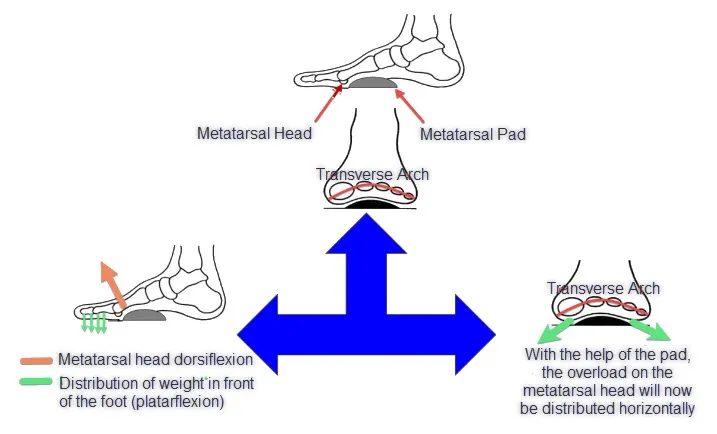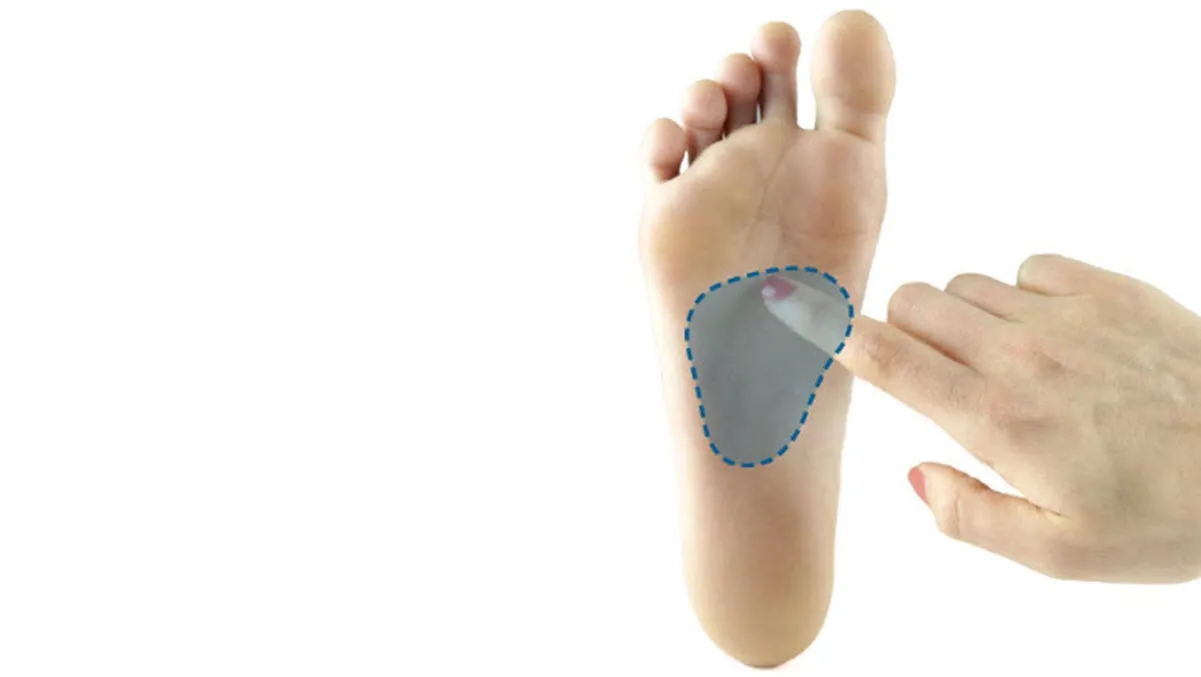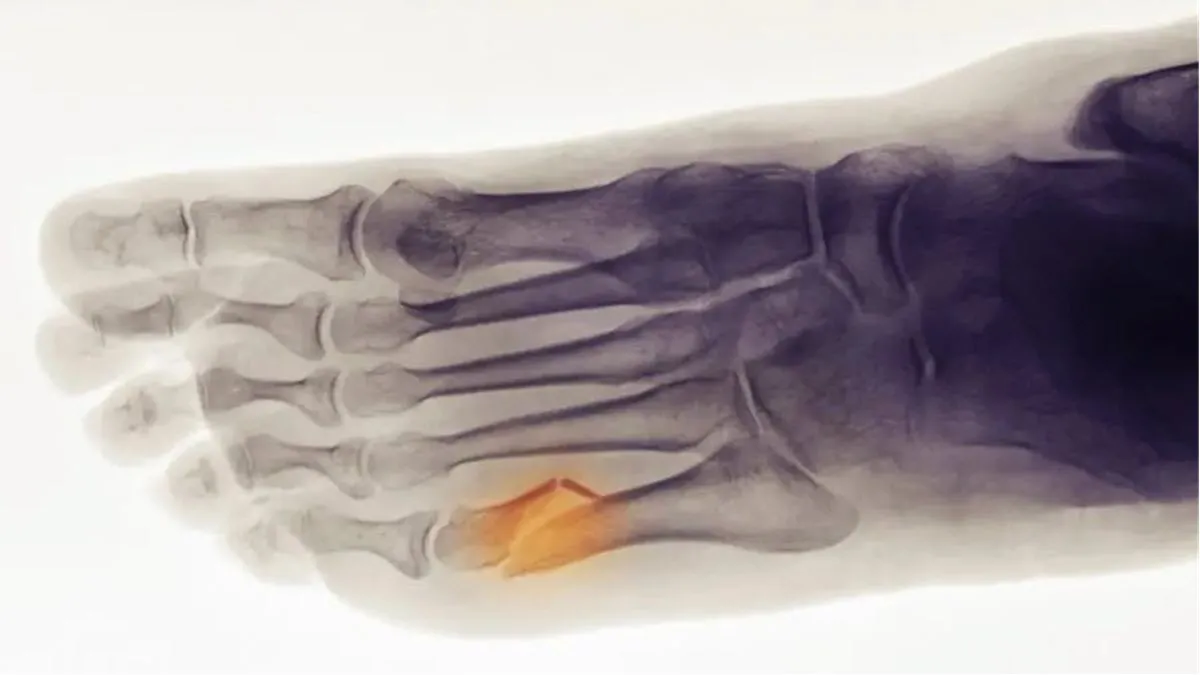Introduction
Metatarsal pads, also known as forefoot pads, are ergonomic devices designed to provide specific support to the front of the foot, where the metatarsals are located. These small pads are positioned under the sole of the foot, just behind the toes, to effectively distribute pressure and reduce friction points in this sensitive area.
Their primary role is to relieve foot pain, often associated with problems such as metatarsalgia, heel spurs, corns, or simply discomfort related to excessive pressure on the ball of the foot. The metatarsal pads act as shock absorbers, absorbing shock from prolonged walking or standing, which helps alleviate pressure on the metatarsals.
By providing additional support to the plantar arch and reducing the load on sensitive areas, these pads can improve overall foot comfort. They are often used as a non-invasive solution to treat various foot conditions, providing significant relief while promoting a more natural gait.
Whether to alleviate existing pain or prevent problems from developing, the judicious use of metatarsal pads can play a crucial role in maintaining foot well-being. In this introduction, we will explore the benefits and applications of these devices in more detail, highlighting their contribution to a comfortable and pain-free gait.
Metatarsal pads prove to be valuable tools in maintaining a balanced posture and comfort of the feet. Their strategic use aims to distribute the transverse arch, located behind the sole of the foot, to optimize weight distribution and promote a more natural gait.
The fundamental key when applying these metatarsal pads is their precise placement. It is imperative to ensure that they exert pressure in the space behind the sole of the foot, rather than under it. This targeted pressure acts directly along the transverse arch, just behind the metatarsal heads, ensuring optimal weight distribution.
By acting in this specific area, the metatarsal pads induce plantar flexion of the toes. This beneficial action has the effect of shifting the weight more from the sole of the foot towards the toes, promoting a more balanced distribution of the load. In other words, the metatarsal pad acts as a vital support, propagating the transverse arch of the foot laterally while eliciting plantar flexion of the toes forward.
This dual function of the metatarsal pads not only helps improve stability and comfort, but it also promotes a more natural and balanced gait. Whether to relieve existing discomfort or to prevent possible problems, the judicious use of these pads can play a significant role in maintaining optimal podiatric health. Thus, by fully understanding the role and appropriate positioning of the metatarsal pads, one can best exploit their potential for worry-free walking and harmonious distribution of body weight.

Correctly Position the Pad
Step 1: Remove the Insole Start by carefully removing the insole from the shoe. This will allow for more accurate identification of the optimal location to place the metatarsal pad. In the case of shoes without lining or insole, the cushion can be positioned directly inside the shoe.
Step 2: Locate the Placement Target Carefully examine the insole. Observe where the ball of the foot naturally lands when wearing the shoe. Identify this area in particular by observing the depressions left by the foot on the insole.
Step 3: Match the Spotted Point with the Pad Place your foot on the insole with the metatarsal pad positioned exactly where identified. Make sure it aligns precisely with the sole of the foot, providing gentle, comfortable pressure.
Step 4: Peel a Quarter of the Adhesive and Test the Pad Carefully peel a quarter of the adhesive from the pads and place it on the exact point chosen for placement. This allows you to test the position of the buffer before fixing it definitively.
Step 5: Place the Cushion in the Shoe and Place the Foot Place the insole back into the shoe with the metatarsal pad correctly positioned. Put the shoe on, making sure the feel of the pad is exactly behind the ball of the foot.
Step 6: Adjust if Necessary Check the feel of the metatarsal pad. If adjustments are necessary to ensure a perfect fit, take the time to make them. In case the cushion needs to be wrapped around the foot or insole, make sure this is done comfortably and securely.

Use for Specific Problems
Metatarsal pads are versatile devices that can provide effective relief for various foot-related problems. Here’s how they can be used to treat specific issues like spurs and painful forefoot:
1. Heel Spurs:
- Positioning: Place the metatarsal pad under the front of the foot to relieve pressure on the heel.
- Extra support: Some pad models are designed with extra support in the arch, which can help reduce strain on the heel.
2. Painful Forefoot (Metatarsalgia):
- Targeting Metatarsalgia: Center the metatarsal pad under the metatarsal area to evenly distribute pressure.
- Forefoot Cushioning: The pads provide additional cushioning, reducing impact on the forefoot and relieving pain associated with metatarsalgia.
3. Pain related to running or walking:
- Shock Absorption: Some pads are designed with shock-absorbing materials, making them ideal for high-impact activities.
- Pressure Reduction: By reducing pressure on the metatarsals, the pads help prevent pain caused by prolonged running or walking.
4. Comfort for Heeled Shoes:
- Discreet Insertion: Discreet metatarsal pads can be inserted into heeled shoes to provide support without compromising style.
- Posture Maintenance: By supporting the front of the foot, the pads help maintain a comfortable posture while wearing heeled shoes.
5. Plantar Aponeurosis:
- Arch Support: Some metatarsal pads are designed with arch support, providing additional relief for those suffering from plantar fasciitis.
Effects on Posture and Gait
Effects of Metatarsal Pads on Posture and Walking
Metatarsal pads, when used correctly, can have beneficial effects on posture and walking, helping to improve comfort and mobility. Here is how these devices can influence these essential aspects:
1. Arch Support:
- Improved Posture: Metatarsal pads designed with arch support help maintain the natural arch of the foot, promoting a more balanced and aligned posture.
2. Reduction of Pressure on the Forefoot:
- Increased Comfort: By evenly distributing pressure across the metatarsal area, the pads relieve pressure points, reducing discomfort and improving overall comfort.
3. Correction of Pronation or Supination:
- Increased Stability: Some metatarsal pads are designed to correct excessive pronation or supination, helping to stabilize the foot during walking and preventing unwanted movement.
4. Shock Absorption:
- Impact Reduction: Metatarsal pads with shock-absorbing properties absorb impact when walking, alleviating pressure on joints and muscles.
5. Prevention of Fatigue:
- Improved Mobility: By relieving tension in the metatarsal region, these pads help prevent premature fatigue, allowing for smoother and more comfortable walking.
6. Shoe Fit:
- Maintaining Natural Mobility: The discreet metatarsal pads fit most shoes, providing support while allowing natural mobility of the foot.
7. Repercussions on Long-Term Walking:
- Relief for Prolonged Activities: For people engaged in prolonged activities such as hiking, metatarsal pads can provide relief by minimizing fatigue and discomfort.
Additional Exercises
Additional Exercises to Strengthen the Feet with Metatarsal Pads
The use of metatarsal pads can be complemented by exercises aimed at strengthening the feet and improving stability. Here are some simple exercises you can incorporate into your routine:
- Calf and Toe Stretch:
- Starting position: Stand with feet shoulder-width apart.
- Movement: Bend your knees slightly and lean forward to grab your toes. Hold for 15 to 30 seconds to stretch your calf and toe muscles.
- Marbles Collected with Feet:
- Materials needed: A small bowl and marbles.
- Movement: Use your toes to pick up the marbles from the floor and drop them into the bowl. This exercise strengthens the intrinsic muscles of the foot.
- Heel Elevation:
- Starting position: Stand with feet shoulder-width apart.
- Movement: Slowly lift your heels off the floor, standing on your tiptoes. Then lower them gently. Repeat to strengthen the calf muscles.
- Writing the Alphabet with the Feet:
- Movement: Sitting or lying down, raise one leg and draw the alphabet in the air with your big toe. Repeat with the other leg. This strengthens the muscles of the foot and ankle.
- Ball Roll Underfoot:
- Equipment needed: A tennis ball.
- Movement: Gently roll a tennis ball under your foot using light pressure. Focus on the metatarsal area to stimulate the muscles and joints.
- Toe Flexions:
- Starting position: Sit in a chair with your feet flat on the floor.
- Movement: Flex the toes upward as much as possible, then release. Repeat several times to strengthen the muscles on the top of the foot.
- Walk on Heels:
- Movement: Walk a short distance standing on your heels only, lifting your toes off the ground. This strengthens the calf and ankle muscles.
Avoid Common Mistakes
- Inappropriate Size: Choosing the wrong size metatarsal pad can compromise its effectiveness. Be sure to measure your foot size correctly and select pads that fit comfortably in your shoes.
- Incorrect Positioning: Placing the pads incorrectly can reduce their benefits. Make sure you position them correctly under the front of the foot, just behind the metatarsal heads, for optimal support.
- Prolonged Use Without Break: Wearing metatarsal pads continuously without break can cause muscle fatigue. It is recommended to take regular breaks to allow the feet to rest.
- Improper Cleaning: Failure to properly maintain the metatarsal pads can lead to a buildup of bacteria. Follow the manufacturer’s cleaning instructions and be sure to maintain proper hygiene.
- Selection of Unsuitable Materials: Some metatarsal pads are made from allergenic materials. Check the product components to avoid any risk of allergy or skin irritation.
- Ignoring Medical Advice: If you have pre-existing foot problems or medical conditions, consult a healthcare professional before using metatarsal pads. Ignoring medical advice can make certain problems worse.
- Failure to Follow Instructions for Use: Carefully follow the manufacturer’s instructions regarding daily usage time, replacement of pads, and any other specific recommendations. Failure to follow these instructions may compromise results.
- Use with Unsuitable Shoes: Metatarsal pads may not function properly with certain types of shoes. Make sure they are compatible with your usual shoe style to ensure a proper fit.
Frequently Asked Questions About Metatarsal Pads
- What are metatarsal pads for? Metatarsal pads are designed to provide additional support to the forefoot, particularly under the metatarsal heads. They help relieve pressure, reduce foot pain, and improve comfort during prolonged walking or standing.
- How to choose the right size metatarsal pads? To choose the right size, measure the length of your feet and refer to the size guides provided by the manufacturers. Make sure the pads fit comfortably in your shoes without creating excessive friction.
- Can I use metatarsal pads with any type of shoe? In general, metatarsal pads are designed to fit a variety of shoes, but it is essential to check their compatibility with your usual shoe style. Some models may be better suited to specific shoes.
- How long can I wear metatarsal pads? Duration of use depends on individual comfort and tolerance. Start with shorter sessions and gradually increase the time of use. Take regular breaks to allow your feet to rest.
- Are metatarsal pads suitable for everyone? Although beneficial for many people, metatarsal pads may not be suitable for everyone. Consult a healthcare professional if you have pre-existing foot problems, medical conditions, or are unsure about their use.
- How to clean metatarsal pads? Follow the manufacturer’s cleaning instructions. In general, most metatarsal pads can be cleaned with a damp cloth. Some models can also be washed by hand. Make sure to maintain proper hygiene to avoid any skin irritation.
- Can metatarsal pads relieve spurs? Yes, properly positioned metatarsal pads can help relieve pressure on heel spurs, providing some relief from associated pain.
- Can I use metatarsal pads for running? Some metatarsal pads are specifically designed for sporting activities, including running. Choose models adapted to this activity for optimal support.
Conclusion
When incorporated appropriately into the daily routine, metatarsal pads can positively influence posture, gait and overall mobility. However, it is crucial to choose pads tailored to your specific needs and to consult a healthcare professional if problems persist.
It is essential to choose the right type of pad based on the specific problem you are experiencing. Consult a healthcare professional or foot specialist for personalized advice on the use of metatarsal pads based on your specific needs.
In conclusion, judicious use of the metatarsal pad can provide significant relief from discomfort related to the soles of the feet, thereby improving not only daily comfort, but also long-term podiatric health. By following the proper steps for placement of the metatarsal pad, removing the insole, precisely locating the area of application, and adjusting the positioning as needed, the benefits of this device can be maximized. Balanced weight distribution, stimulating plantar flexion of the toes and creating a more natural gait are the key elements that contribute to a balanced posture, worry-free walking and prevention of future podiatric problems. Let’s not forget that the support of a health professional, in particular a podiatrist, can offer personalized advice to maximize the benefits of the metatarsal pad according to individual needs. By integrating this simple but effective solution into our routine, we are taking meaningful steps to maintain the health of our feet and promote an active and comfortable life.

























